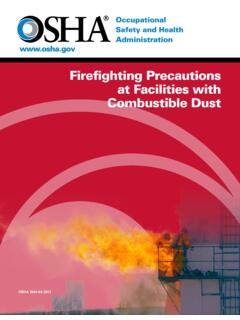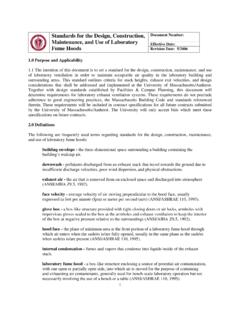Transcription of “Electrical Safety in the Workplace” - Occupational Safety and …
1 Electrical Safety in the Workplace This material was produced under Grant #SH-16609-07-60-F-26 from the Occupational Safety and Health Administration, Department of Labor. It does not necessarily reflect the views or policies of the Department of Labor, nor does mention of trade names, commercial products, or organizations imply endorsement by the Government. September 2008 Electrical Safety in the Workplace 2 Course Goal The aim of this program is to provide comprehensive on-site training to high-risk workers ( skilled trades and maintenance workers) and management on the requirements of Sub Part S, and the prevention of serious injuries from electrical hazards at their worksites. Participants will develop understanding of the requirements of OSHA Sub Part S and nfpa , 70E and will be able to identify and reduce or eliminate electrical Safety hazards in their workplace.
2 Electrical Safe Work Practices including electrical Safety principles, guidelines for qualification of personnel, job planning requirements and Management and Personal Responsibility will be covered. Section Content Objective 1 Introduction to Electrical Safety Participants will be able to: Explain the issues (statistics) associated with poor electrical Safety in the workplace. Recall key electrical terms which are essential to understanding and meeting the requirements of key electrical Safety standards; OSHA 29 CFR , nfpa 70E, NEC ( nfpa 70) Define and differentiate between qualified and unqualified persons under OSHA Sub Part S. and the training requirements for each. Describe the intent of an Electrical Safety Program and list the essential elements of an effective program. Use a Status Check survey to assess the facility s electrical Safety program and where necessary develop strategies for improvement.
3 2 Identifying the Hazards Participants will be able to: List types of electrical hazards to personnel and describe the nature of the hazards related to: o Electric shocks, arcs and blasts o Fault current and potential difference o Electrical Safety in industrial plants List the characteristics of an arc flash hazard List the characteristics of an arc blast hazard Explain how other injury hazards are related to shock, flash, and blast 3 OSHA Requirements Participants will be able to: Identify requirements specified in OSHA 29 CFR and nfpa 70E- 2004 Chapter 4 and describe similarities and differences in OSHA and 70E. Explain how nfpa 70E is used in OSHA compliance and enforcement. Determine training for workers in accordance with OSHA Sub Part S requirements. Recall Safe Installation Practices including: o Guarding o Identification o Flexible cords and cables o System grounding o Location of overcurrent protection devices o Workspace clearance requirements Assess an electrical installation for compliance with OSHA regulations.
4 Explain the reasons for doing a site assessment to determine arc flash hazard potential for equipment and electrical enclosure. 4 Safety Related Work Practices Participants will be able to: Identify requirements for electrical safe work practices specified in OSHA 29 CFR and nfpa 70E Chapter 1 Define an Electrically Safe Work Condition and list specific steps to be taken to ensure an electrically safe work condition. Explain how the creation of an electrically safe work condition can involve hazards Electrical Safety in the Workplace 3and the methods to protect against them. Describe the facility s lockout/tagout (LO/TO) procedure including requirements and activities in the procedure and identify the persons responsible for each activity.
5 Determine the LO/TO procedure applicable to a given facility, operation, equipment or activity. Describe other Safety related work practices to protect from electrical hazards including: o Selection and use of work practices o De-energized work practices o Energized work practices o Approach boundaries and approach distances o Requirements for use of test instruments and equipment o Requirements for insulated tools o Other equipment such as ladders, barricades, signs 5 Working On or Near Live Parts Participants will be able to: Identify persons who may be exposed to a source of electrical energy directly or indirectly. List the conditions under which hot work is allowed. Describe the purposes of an energized electrical work permit. Recall three types of approach boundaries and define the dimensions of each approach boundary, given all necessary information.
6 Describe the essential parts of a Flash Hazard Analysis and list the data required analysis. List the information, including Hazard Risk Category, provided to a worker by a Flash Hazard Analysis and describe its use. 6 Personal Protective Equipment (PPE) Participants will be able to: List the basic types of personal protective equipment (PPE) for tasks involving electrical hazards. Describe how each type protects against hazards and identify the limitations of PPE. Explain the need for flame resistant (FR) clothing and layering of clothing for protection and list clothing prohibited where electrical hazards are present. Select PPE for a given Hazard Risk Category including gloves, eye, head, face protection and (FR) clothing. Describe the requirements for use, care, maintenance and storage of PPE. 7 Action Planning and Course Wrap-up Participants will be able to: Outline an Action Plan to achieve compliance with OSHA Subpart S and nfpa 70E.
7 Provide assistance to help achieve workplace goals of OSHA Subpart S and nfpa 70E compliance. Electrical Safety in the Workplace 4 AGENDA Section Content Page # 1* Introduction to Electrical Safety 6. 2* Identifying the Hazards 13. 3* OSHA Requirements 28. 4 Safety Related Work Practices 33. 5 Working On or Near Live Parts 35. 6 Personal Protective Equipment 40. 7 Action Planning and Course Wrap-up 62. * Denotes Electrical Hazard Awareness training sections. Electrical Safety in the Workplace 5 Introductions Individual Introductions: Your name, worksite, local union, job title and/or Union title Introductions: 1.
8 How long have you been doing electrical repairs or troubleshooting? _____ 2. What electrical responsibilities do you know are within your training? 1) _____ 2) _____ 3. What electrical responsibilities do you know are outside your training? 1) _____ 2) _____ 4. What type of Personal Protective Equipment (PPE) is available to you when working on or near live electrical equipment? _____ Answer the following throughout the session -- 5. What action does your facility need to take to comply with the revised Electrical Standards? Sticky notes are at the tables. As we cover ideas, you ll think, Our facility needs to do (fill in the blank) to take care of this! When you do, write that action on a post-it note, along with the page number that sparked it. Pile the notes in front you. They will be used in the wrap-up planning exercise.
9 Electrical Safety in the Workplace 6 A Checklist to Clarify Status Column 1 -- Do these items describe your facility? Answer YES, NO, or SOMEWHAT ITEM -- Each sentence starts with Does Your 1 1..work on 50V or more? 2..have all breakers and switches marked for what it goes to? 3..provide Lockout/Tagout (LOTO) training for everyone? 4..provide GFI protection for extension cords and electric portable tools? 5..provide Flame Retardant (FR) clothing to qualified personnel? 6..stress LOTO before doing any service or maintenance on electrical components? 7..inspect electrical cords on portable tools and extension cords prior to each use? 8..have a procedure for taking damaged cords out of service for repairs prior to use? 9..have all panels / Electrical Cabinets marked for voltage?
10 10..provide Electrical Hazard Awareness Training for everyone? 11..reset breakers with qualified personnel? 12..have an electrical room or vault? 13..is the room secured to prevent unqualified personnel from entering? 14..use dielectric tested gloves when working on/near live electrical parts? 15..use insulated tools when working on/near live electrical parts? 16..do Preventitive Maintenance on circuit breakers and switches at least annually? 17..have 40 cal/cm2 suits available? 18..have buss plugs that are changed by personnel? 19..work on live electrical equipment to trouble shoot or because it can t be shut down? 20..have all the incident energy calculated and Arc Flash Boundaries set for all service connections of 50V or more? 21..are the boundaries posted on panels/disconnects? 22..use a Hot Electrical Work Permit system? 23.. install new equipment or rebuild older equipment?












